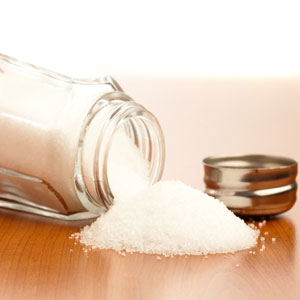
How many teaspoons do you take? Of salt that is. Not even one a day? Think again.
Sadly, taking the decision not to add salt to your food is not necessarily enough to reduce your consumption to the recommended daily limit of 1 teaspoon. The reason? Food manufacturers are all too liberal with the use of salt in the preparation of everyday foods. But this does not condone adding salt at the table. In fact in South Africa, up to 40% of the salt we ingest comes from the salt shaker!
Take a look at this typical daily menu including foods we consume every day to see how salt can add up.
- Breakfast: A bowl (40g) of cornflakes with milk - 1.4g (about 1/4 tsp of salt)
- Lunch: A sandwich on white bread with hard margarine, polony and cheese - 2.9g (almost 1/2 tsp of salt)
- Snack: A medium packet or cheese curls or Nik Naks - 1.1 g (almost 1/5 tsp of salt)
- Supper: A 360g portion of Regina pizza - 6.2g (more than 1 tsp of salt)
On a diet such as this you are taking in more than 11.6g of salt on a daily basis. This is more than double the World Health Organisation (WHO) recommended limit of no more than 5g (just under 1 teaspoon) of salt per day. You may start to get an idea of how quickly this limit is reached! And this is not even taking into account the salt added at the table, called discretionary salt.
Unsurprisingly, research tells us that dietary salt intake has increased tenfold over the last few hundred years. But why is this harmful? Essentially because salt causes increased blood pressure or hypertension, which increases your chances of having a stroke, heart attack, heart failure or developing kidney disease. Moreover, high salt intake is a probable promoter of gastric cancer and is associated with osteoporosis. Salt is also associated with increased asthma severity and obesity. Seems like a lot of extra risk to take on board, just to spice up your food with added salt.
Still not convinced?
Here are some hard facts, specifically about salt and strokes:
- Fact: increasing salt consumption tracks rising blood pressure levels.
- Fact: salt raises blood pressure, and high blood pressure is the single most important risk factor for stroke.
- Fact: reducing daily salt intake, even by just 1g/day, can lower blood pressure, and prevent thousands of deaths from heart disease and stroke.
What exactly happens when you have a stroke?
A stroke happens when the blood supply to the brain is interrupted. It happens suddenly and can cause immediate loss of feeling and weakness, usually on one side of the body. A stroke can also affect speech, vision, memory and emotions.
The effects of a stroke are devastating, often resulting in early death or permanent disability. If you even survive a stroke, it often puts an enormous burden on family members or carers. Moreover, stroke-related medical costs and disability put major strain on family finances. In South Africa, statistics show that over 25 000 South Africans die every year as a result of strokes. Even more survive, but are disabled.
- Fact: getting rid of the salt shaker is one way to reduce your salt intake and is a small price to pay to drastically reduce your chances of suffering a stroke.
What can be done?
The good news is that the Department of Health is in the process of legislating on the maximum sodium allowed in certain foods, which will help against excessive use of salt in the food manufacturing process. Such legislation will bring South Africa in line with the UK, Australia and US (New York), which have all implemented national dietary salt reduction programmes in consultation with hypertension experts.
Our advice? Whilst government is legislating to reduce the salt content of foods, it is up to every individual to actively reduce their own daily consumption of salt. So hide that salt shaker! Everyday foods in South Africa already contain far too much salt, so adding more at the dinner table is one habit you need to kick. Avoid salty foods as much as possible and try to stick to the South African Hypertension Guidelines of 2011 and the WHO recommended limit of 5g (< 1 teaspoon) per day. It could just save your life.
Read labels and shop smart
Next time you are in the shop, take some time to familiarise yourself with food labels. Look at the ingredients list – if the words ‘salt’ or ‘sodium’ appear in the top few ingredients, the product contains a lot of salt – so its best to move on to a better option!
Have a look at the nutritional information table on the label and look out for the grams of sodium (Na) that the food item contains and simply multiply this number by 2.5 to calculate the amount of salt in grams.
Use this as a general rule when choosing foods containing salt:
- More than 1.5g per 100g are HIGH in salt – rather avoid these!
- Less than 0.3g per 100g are LOW in salt – choose these more often.
For an easy guide, look out for Heart Mark products. The trusted Heart Mark helps you identify food products that are lower in salt content.
Heart and Stroke Foundation press release
(Pic of salt shaker from Shutterstock)
Read more:
Salt: the slow, silent killer
Top 10 salty food culprits
Bread has high amounts of salt




 Publications
Publications
 Partners
Partners













